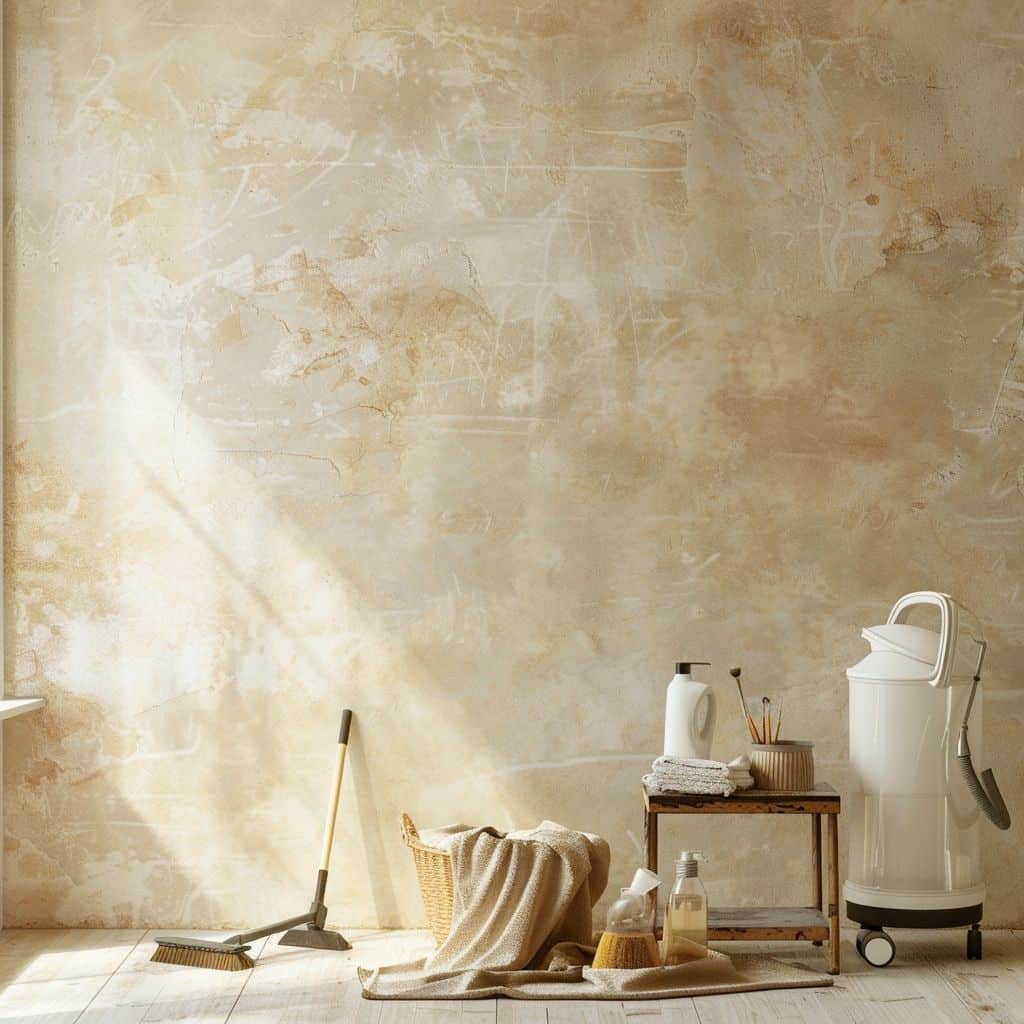The Foundation of a Flawless Finish
Venetian plaster, known for its luxurious and elegant finish, requires meticulous surface preparation to achieve its full potential. Proper preparation ensures that the plaster adheres well, looks smooth, and lasts long. Ignoring these crucial steps can lead to imperfections, poor adhesion, and a subpar finish. Therefore, investing time and effort into cleaning, patching, and priming the surface is essential for a successful Venetian plaster application.
Importance of Proper Surface Preparation
Proper surface preparation is the foundation of a successful Venetian plaster application. By thoroughly cleaning, repairing, and priming the surface, you ensure that the plaster adheres correctly and achieves a smooth, professional finish. Each step in the preparation process addresses potential issues that could affect the final result, making it crucial to follow these steps meticulously.

Cleaning the Surface
Steps for Cleaning
Removing Dust and Debris
The first step in preparing the surface for Venetian plaster is to remove any dust and debris. Use a soft-bristle brush or a vacuum cleaner with a brush attachment to sweep away loose particles. This step ensures that no dust will interfere with the plaster’s adhesion.
Cleaning Grease and Stains
Grease and stains can prevent the plaster from adhering properly. Clean the surface with a mild detergent solution to remove any grease or grime. For stubborn stains, consider using a specialised cleaner. Ensure that all cleaning solutions are thoroughly rinsed off and the surface is left to dry completely before proceeding.
Tools and Materials for Effective Cleaning
- Soft-bristle brush or vacuum cleaner: For removing dust and loose debris.
- Mild detergent: To clean grease and grime.
- Specialised cleaners: For stubborn stains.
- Clean water and cloths: To rinse and dry the surface.
Importance of a Clean Surface
Ensuring Proper Adhesion of Venetian Plaster
A clean surface is critical for the proper adhesion of Venetian plaster. Any remaining dust, grease, or stains can prevent the plaster from bonding effectively, leading to peeling or blistering over time. Thorough cleaning ensures that the plaster adheres smoothly and securely.
Preventing Imperfections in the Final Finish
Impurities left on the surface can cause imperfections in the final finish of the plaster. Dust particles can create bumps, while grease and stains can result in uneven application and discolouration. Cleaning the surface meticulously helps to achieve a flawless, professional finish that enhances the beauty of Venetian plaster.
Patching and Repairing
Identifying Surface Imperfections
Common Issues: Cracks, Holes, and Uneven Areas
Before applying Venetian plaster, it’s essential to inspect the surface for imperfections. Common issues include cracks, holes, and uneven areas. These flaws can disrupt the smooth application of plaster and affect the final appearance. Carefully examine the surface under good lighting to identify any areas that need attention.
Assessing the Extent of Repairs Needed
Once you have identified surface imperfections, assess the extent of the repairs needed. Small cracks and minor holes can usually be fixed with basic patching techniques, while larger damages may require more extensive repairs. Evaluate whether the surface is stable and sound enough for plaster application, or if additional structural repairs are necessary.
Techniques for Patching and Repairing
Materials and Tools Required for Patching
- Patching compound or filler: Suitable for the type of wall (e.g., drywall, plaster, or masonry).
- Putty knife or trowel: For applying the patching compound.
- Sandpaper: Medium to fine grit for smoothing the patched areas.
- Primer: To seal the repaired areas before plastering.
Step-by-Step Guide to Repairing Surface Imperfections
- Clean the Area: Ensure the area to be patched is clean and free of dust or debris.
- Apply Patching Compound: Use a putty knife or trowel to apply the patching compound or filler to the cracks and holes. Spread the compound evenly, filling the imperfections completely.
- Smooth the Surface: Smooth out the patching compound with the putty knife, removing any excess and ensuring it is level with the surrounding surface.
- Let It Dry: Allow the patching compound to dry according to the manufacturer’s instructions.
- Sand the Patched Areas: Once dry, sand the patched areas with medium to fine-grit sandpaper until smooth and flush with the surrounding surface.
- Wipe Down: Wipe down the sanded areas with a damp cloth to remove any dust from sanding.
Ensuring a Smooth, Even Surface Before Priming
After patching and sanding, inspect the surface again to ensure it is smooth and even. Run your hand over the repaired areas to check for any remaining rough spots or irregularities. If necessary, repeat the patching and sanding process until the surface is perfectly smooth. A well-prepared surface is crucial for achieving a professional-looking Venetian plaster finish.
Priming for Venetian Plaster
Importance of Priming
Enhancing Adhesion of the Plaster
Priming the surface is a critical step in the Venetian plaster application process. Primers create a bonding layer that enhances the adhesion of the plaster to the substrate. Without a proper primer, the plaster may not adhere correctly, leading to peeling or flaking over time.
Creating a Uniform Base for Application
Priming also helps create a uniform base for the plaster application. It seals the surface, preventing any uneven absorption of moisture from the plaster. This uniformity is essential for achieving a smooth and consistent finish, as it allows the plaster to dry evenly across the entire surface.
Choosing the Right Primer
Types of Primers Suitable for Venetian Plaster
- Acrylic Primers: Water-based primers that provide excellent adhesion and are easy to apply. Suitable for most surfaces.
- Mineral Primers: Lime-based primers that are ideal for traditional lime plasters. They enhance the natural properties of Venetian plaster.
- Universal Primers: Designed to work on various surfaces, providing flexibility and strong adhesion.
Factors to Consider When Selecting a Primer
- Surface Type: Choose a primer that is compatible with the substrate (e.g., drywall, masonry, or previously painted surfaces).
- Plaster Type: Ensure the primer is suitable for the specific type of Venetian plaster being used.
- Environmental Conditions: Consider the temperature and humidity levels during application, as they can affect the drying time and performance of the primer.
Application Techniques
Tools Needed for Priming
- Paint Roller or Brush: For applying the primer evenly across the surface.
- Paint Tray: To hold the primer for easy access during application.
- Drop Cloths or Protective Coverings: To protect the surrounding area from spills and splatters.
Step-by-Step Guide to Applying Primer
- Prepare the Surface: Ensure the surface is clean, dry, and free from dust or debris.
- Stir the Primer: Mix the primer thoroughly to ensure an even consistency.
- Apply the Primer: Use a paint roller or brush to apply the primer to the surface. Work in sections, starting from the top and working your way down.
- Ensure Even Coverage: Make sure the primer is applied evenly, avoiding any drips or puddles. Use smooth, overlapping strokes.
- Let It Dry: Allow the primer to dry according to the manufacturer’s instructions. This typically takes a few hours, but drying times can vary based on the product and environmental conditions.
Drying Time Considerations and Tips for Best Results
- Check Manufacturer’s Instructions: Always follow the specific drying time recommended by the primer manufacturer.
- Optimal Conditions: Ensure the area is well-ventilated and maintain a stable temperature and humidity level to promote proper drying.
- Multiple Coats: If applying multiple coats of primer, ensure each coat is fully dry before applying the next one.
Conclusion
Recap of the Importance of Surface Preparation
Surface preparation is a crucial step in achieving a flawless Venetian plaster finish. By meticulously cleaning, patching, and priming the surface, you ensure that the plaster adheres properly, looks smooth, and lasts longer. Neglecting these steps can lead to imperfections, poor adhesion, and a subpar finish.
Summary of Cleaning, Patching, and Priming Steps
- Cleaning the Surface: Remove dust, debris, grease, and stains to ensure proper adhesion and prevent imperfections.
- Patching and Repairing: Identify and repair cracks, holes, and uneven areas to create a smooth, even base.
- Priming for Venetian Plaster: Apply a suitable primer to enhance adhesion and create a uniform surface for plaster application.
Final Tips for Ensuring a Flawless Venetian Plaster Application
- Thorough Inspection: Inspect the surface at each stage of preparation to ensure no imperfections are missed.
- Quality Materials: Use high-quality cleaning agents, patching compounds, and primers to achieve the best results.
- Patience: Allow adequate drying time between each step to ensure the surface is fully prepared for the next phase.
By following these steps meticulously, you lay the foundation for a successful Venetian plaster application that will enhance the beauty and durability of your walls.
Surface Preparation for Venetian Plaster in Sydney by Venetian Plasterer
At Venetian Plasterer, we understand the critical role of surface preparation in achieving a perfect Venetian plaster finish. Providing expert Venetian plastering services across Sydney, our team meticulously handles every step of the preparation process. From thorough cleaning to precise patching and priming, we ensure that your surfaces are perfectly prepped for the application of Venetian plaster. Our dedication to quality and attention to detail guarantees a flawless finish that enhances the elegance and durability of your walls. Trust Venetian Plasterer for all your Venetian plaster needs in Sydney, and experience the difference that professional surface preparation makes.
Related
Classic Venetian Plaster: Composition, Traditional Application Methods, Common Uses and Finishes

